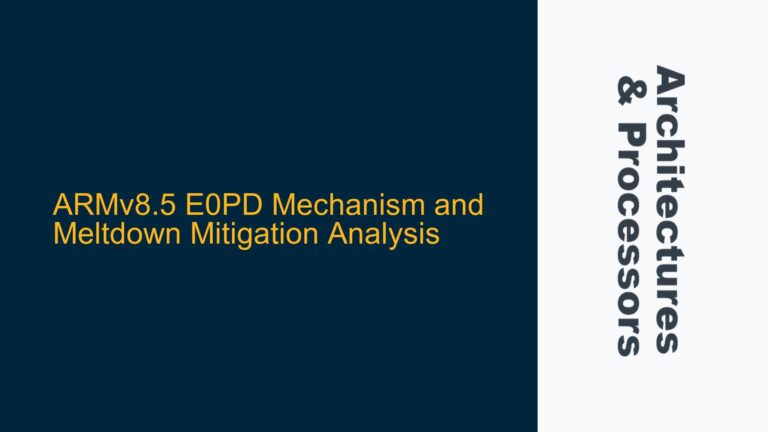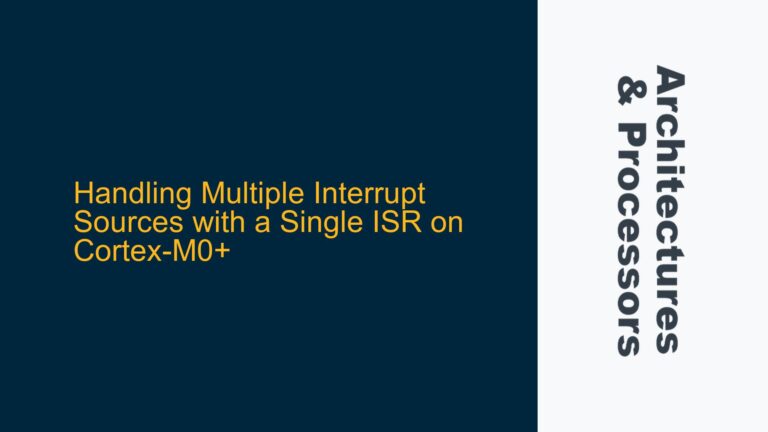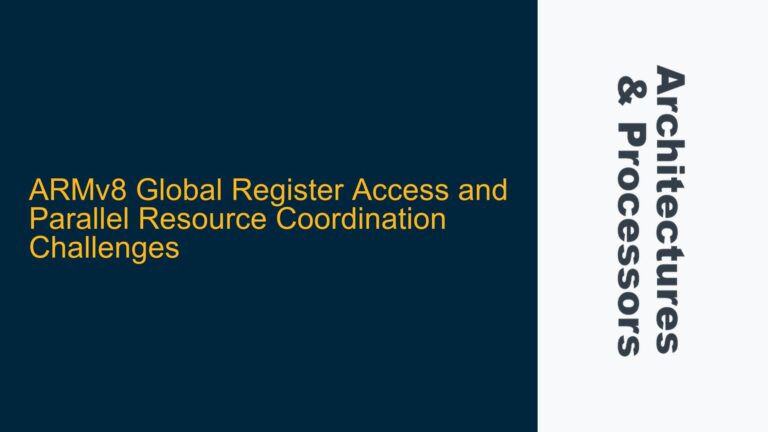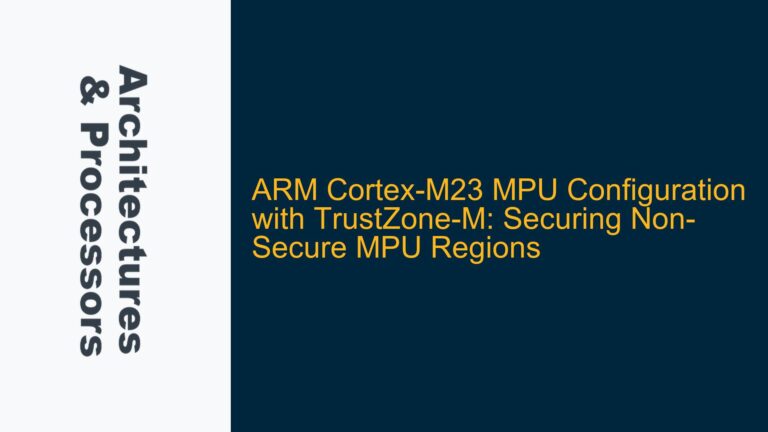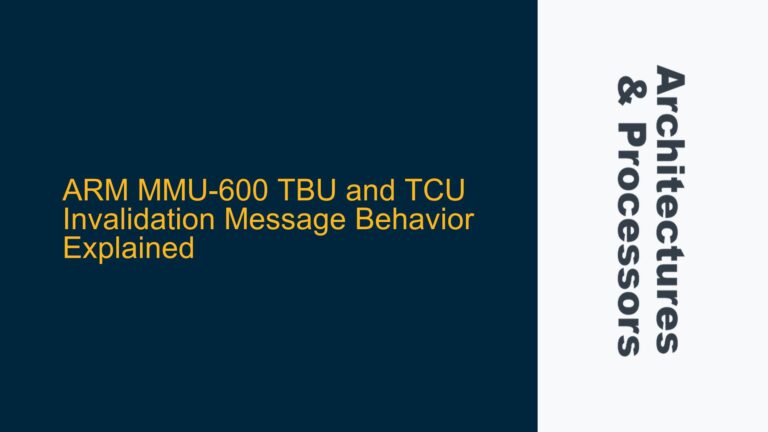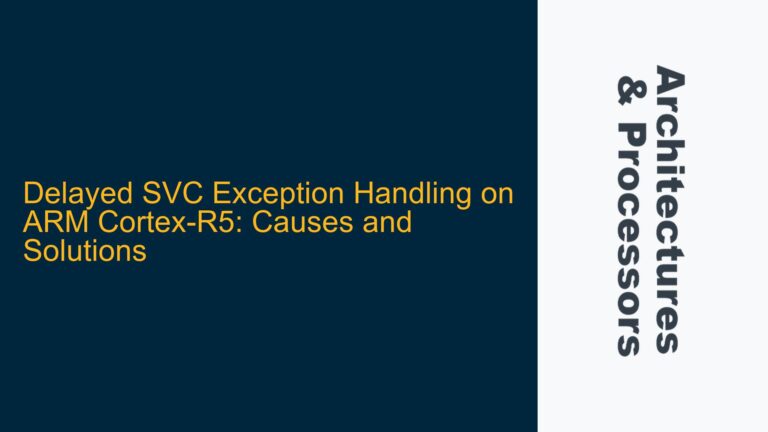ARM Cortex-M0 Instruction Execution and GPIO Toggle Timing
The ARM Cortex-M0 processor, used in the LPC1114 microcontroller, is a highly efficient 32-bit RISC processor designed for embedded applications. Understanding its clock cycle activity is crucial for optimizing performance, especially in time-critical tasks such as GPIO toggling. The core issue revolves around the discrepancy between the expected and observed clock cycles required to toggle a GPIO pin using a simple loop. The expected cycle count based on the ARMv6-M instruction set summary is 11 cycles, but the observed cycle count is 15. This discrepancy suggests underlying factors affecting the execution pipeline, memory access timing, or peripheral interactions.
To analyze this issue, we must first break down the instruction execution pipeline of the Cortex-M0, understand the memory access timing for GPIO operations, and consider potential bottlenecks such as bus contention, wait states, or pipeline stalls. The Cortex-M0 uses a 3-stage pipeline (Fetch, Decode, Execute), and each instruction’s execution time depends on its type and the memory subsystem’s behavior. Additionally, the LPC1114’s memory map and peripheral bus architecture play a significant role in determining the actual cycle count.
The code in question performs the following operations in a loop:
- Load the base address of the GPIO0DATA register into R0.
- Load the current value of the GPIO0DATA register into R1.
- Prepare a bitmask to toggle PIO0_3 in R2.
- XOR the current GPIO value with the bitmask to toggle the pin.
- Store the modified value back to the GPIO0DATA register.
- Branch back to the start of the loop.
Each of these operations has a defined cycle count in the ARMv6-M architecture, but the actual execution time can vary due to factors such as memory wait states, bus arbitration, and pipeline dependencies.
Pipeline Stalls, Memory Wait States, and Peripheral Latency
The observed 15-cycle toggle time for PIO0_3 can be attributed to several factors that extend the execution time beyond the theoretical minimum. These factors include pipeline stalls, memory wait states, and peripheral access latency.
Pipeline Stalls: The Cortex-M0’s 3-stage pipeline can experience stalls due to data dependencies or branch instructions. In the given code, the branch instruction at the end of the loop (B loop) introduces a pipeline flush, as the processor must fetch the next instruction from a new address. This flush adds extra cycles to the loop execution time.
Memory Wait States: The LPC1114’s memory subsystem introduces wait states for certain types of memory accesses. The GPIO0DATA register is located in the peripheral memory region, which may have different access characteristics compared to the core registers or SRAM. Accessing peripheral registers often incurs additional wait states due to the slower response time of the peripheral bus.
Peripheral Latency: The GPIO peripheral itself may introduce latency when reading or writing the GPIO0DATA register. This latency can be caused by synchronization logic within the peripheral, which ensures that read and write operations are properly aligned with the system clock. Additionally, the peripheral bus may experience contention if other peripherals are accessing the bus simultaneously.
Bus Arbitration: The LPC1114 uses an AHB-Lite bus for connecting the Cortex-M0 core to the memory and peripherals. Bus arbitration can introduce delays if multiple masters (e.g., the core and a DMA controller) attempt to access the bus simultaneously. While the provided code does not involve DMA, other peripherals or system activities could still cause bus contention.
Instruction Fetch Timing: The Cortex-M0 fetches instructions from flash memory, which may have a higher latency than SRAM. If the flash memory introduces wait states, the instruction fetch stage of the pipeline will take longer, increasing the overall cycle count.
Detailed Cycle-by-Cycle Analysis and Optimization Strategies
To resolve the discrepancy between the expected and observed cycle counts, we must perform a detailed cycle-by-cycle analysis of the code and identify opportunities for optimization. Below is a breakdown of the expected and observed cycle counts for each instruction in the loop:
| Instruction | Expected Cycles | Observed Cycles | Notes |
|---|---|---|---|
LDR R0, =(0x50003FFC) |
2 | 2 | Load immediate value into R0. No additional latency expected. |
LDR R1, [R0] |
2 | 3 | Load from peripheral memory. Additional wait state due to bus latency. |
MOVS R2, #(1<<3) |
1 | 1 | Move immediate value into R2. No additional latency expected. |
EORS R1, R1, R2 |
1 | 1 | XOR operation. No additional latency expected. |
STR R1, [R0] |
2 | 3 | Store to peripheral memory. Additional wait state due to bus latency. |
B loop |
3 | 5 | Branch instruction. Pipeline flush and instruction fetch latency. |
The observed cycle counts exceed the expected values due to the factors discussed earlier. To address this, we can implement the following optimization strategies:
1. Minimize Pipeline Stalls: Reduce the impact of pipeline flushes by unrolling the loop or using conditional execution. For example, instead of branching back to the start of the loop, we can repeat the GPIO toggle logic multiple times within the loop body. This reduces the frequency of pipeline flushes and improves overall efficiency.
2. Optimize Memory Access: Ensure that the GPIO0DATA register is accessed with minimal wait states. This can be achieved by configuring the memory subsystem to prioritize core accesses or by using a faster memory region for frequently accessed peripherals. Additionally, aligning data structures to reduce bus contention can improve access times.
3. Reduce Peripheral Latency: Configure the GPIO peripheral to minimize synchronization delays. This may involve adjusting the peripheral clock speed or enabling pipelined access modes if supported by the hardware.
4. Improve Instruction Fetch Efficiency: Use the Cortex-M0’s prefetch buffer to reduce instruction fetch latency. The prefetch buffer can store frequently executed instructions, reducing the need to fetch them from flash memory repeatedly. Additionally, placing critical code in SRAM can eliminate flash memory wait states.
5. Bus Arbitration Tuning: If bus contention is a significant factor, prioritize the core’s access to the bus by configuring the bus arbiter. This ensures that the core’s memory accesses are serviced with minimal delay.
By implementing these strategies, we can reduce the observed cycle count closer to the theoretical minimum. For example, unrolling the loop and optimizing memory access can reduce the cycle count from 15 to 12 or fewer cycles. Additionally, using the Cortex-M0’s low-power features, such as sleep modes, can further improve efficiency in applications where power consumption is a concern.
In conclusion, the discrepancy between the expected and observed cycle counts for GPIO toggling on the LPC1114 is primarily due to pipeline stalls, memory wait states, and peripheral latency. By understanding the Cortex-M0’s pipeline architecture and the LPC1114’s memory subsystem, we can identify and address these bottlenecks to achieve optimal performance. The strategies outlined above provide a comprehensive approach to troubleshooting and optimizing cycle counts for time-critical tasks in embedded systems.

